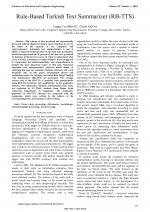| 3/2018 - 15 |
Rule-Based Turkish Text Summarizer (RB-TTS)BIRANT, C. C. |
| Extra paper information in |
| Click to see author's profile in |
| Download PDF |
Author keywords
data processing, dictionaries. morphology, natural language processing, text processing
References keywords
turkish(10), text(6), language(5), summarization(4), information(4), extraction(4), evaluation(4)
Blue keywords are present in both the references section and the paper title.
About this article
Date of Publication: 2018-08-31
Volume 18, Issue 3, Year 2018, On page(s): 113 - 118
ISSN: 1582-7445, e-ISSN: 1844-7600
Digital Object Identifier: 10.4316/AECE.2018.03015
Web of Science Accession Number: 000442420900015
SCOPUS ID: 85052145263
Abstract
The volume of data produced has exponentially increased with the digital revolution and it continues to race to the limits of the capacity of our computers and supercomputers. Automatic text summarization is one of efforts to tame the bestial product of our daily data production, which have generated the 90 percent of the data ever produced by humans, in the last two years. In order to understand what a text is about, a summary is needed which is short enough not to compromise the understandability, and comprehensive to include the most important topics of that text. Numerous automatic text summarization software which aimed at achieving this goal use semantic relations, thesauri, and word frequency lists. In this paper, development phases and evaluation results of a software tool called Rule Based Turkish Text Summarizer (RB-TTS) are presented. The average success rate of the RB-TTS is analyzed both quantitatively using ROUGE-N metrics and qualitatively. In the qualitative analysis, five summaries, obtained automatically from texts, are evaluated by 10 Ph.D. students from Dokuz Eylul University Department of Linguistics. The summaries generated by RB-TTS software are compared with the summaries, which were written by the authors of the corresponding texts, and marked as close to them. |
| References | | | Cited By |
Web of Science® Times Cited: 1 [View]
View record in Web of Science® [View]
View Related Records® [View]
Updated 2 weeks, 5 days ago
SCOPUS® Times Cited: 1
View record in SCOPUS® [Free preview]
View citations in SCOPUS® [Free preview]
[1] Topic-based automatic summarization algorithm for Chinese short text, Ma, Tinghuai, Wang, Hongmei, Zhao, Yuwei, Tian, Yuan, Al-Nabhan, Najla, Mathematical Biosciences and Engineering, ISSN 1551-0018, Issue 4, Volume 17, 2020.
Digital Object Identifier: 10.3934/mbe.2020202 [CrossRef]
Disclaimer: All information displayed above was retrieved by using remote connections to respective databases. For the best user experience, we update all data by using background processes, and use caches in order to reduce the load on the servers we retrieve the information from. As we have no control on the availability of the database servers and sometimes the Internet connectivity may be affected, we do not guarantee the information is correct or complete. For the most accurate data, please always consult the database sites directly. Some external links require authentication or an institutional subscription.
Web of Science® is a registered trademark of Clarivate Analytics, Scopus® is a registered trademark of Elsevier B.V., other product names, company names, brand names, trademarks and logos are the property of their respective owners.
Faculty of Electrical Engineering and Computer Science
Stefan cel Mare University of Suceava, Romania
All rights reserved: Advances in Electrical and Computer Engineering is a registered trademark of the Stefan cel Mare University of Suceava. No part of this publication may be reproduced, stored in a retrieval system, photocopied, recorded or archived, without the written permission from the Editor. When authors submit their papers for publication, they agree that the copyright for their article be transferred to the Faculty of Electrical Engineering and Computer Science, Stefan cel Mare University of Suceava, Romania, if and only if the articles are accepted for publication. The copyright covers the exclusive rights to reproduce and distribute the article, including reprints and translations.
Permission for other use: The copyright owner's consent does not extend to copying for general distribution, for promotion, for creating new works, or for resale. Specific written permission must be obtained from the Editor for such copying. Direct linking to files hosted on this website is strictly prohibited.
Disclaimer: Whilst every effort is made by the publishers and editorial board to see that no inaccurate or misleading data, opinions or statements appear in this journal, they wish to make it clear that all information and opinions formulated in the articles, as well as linguistic accuracy, are the sole responsibility of the author.



